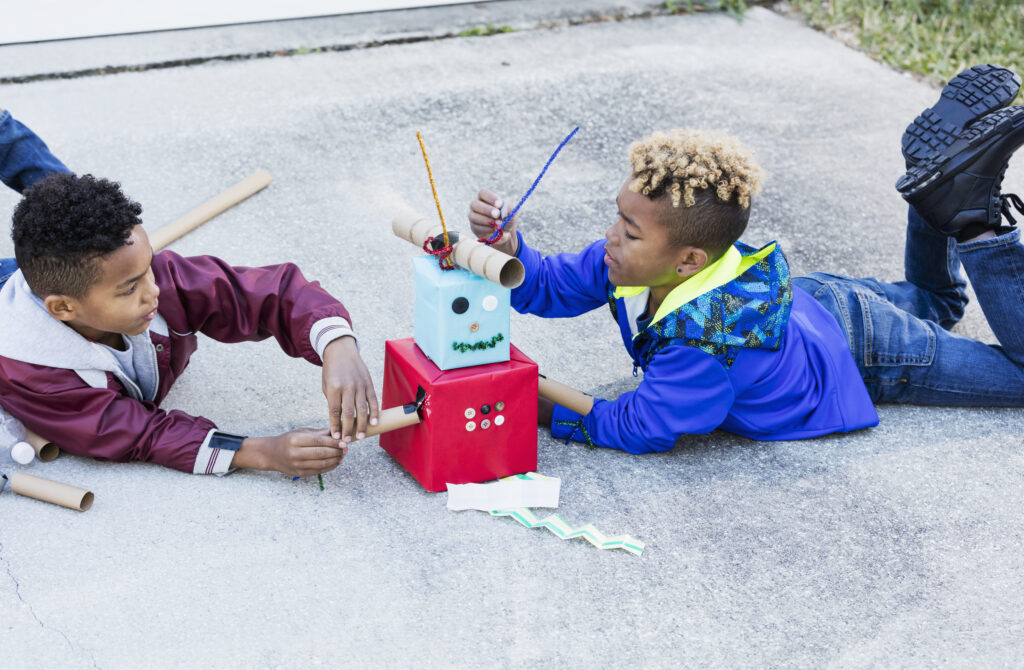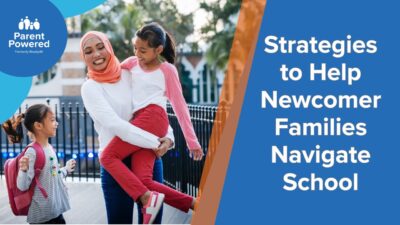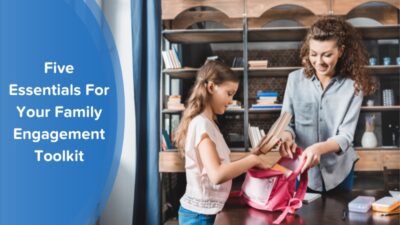by Maren Madalyn, contributing writer
Educators already know the immense benefits that family engagement offers to the entire community, from boosted reading and math scores to increased graduation rates to improved teacher satisfaction and beyond. Strong relationships between families and their schools create supportive learning environments in which students thrive and the adults surrounding them share mutual trust with one another.
But student learning extends beyond school settings, and so should family engagement opportunities. Traditionally, family engagement programs are often school-based and concentrate on extending classroom learning into the home environment.
Examples of such strategies vary widely, too. They include asking families to review homework folders, holding conferences with parents on campus, sending annual parent surveys about school programs, or even asking families to volunteer time in the classroom or at school events. Though helpful, these family engagement strategies provide only limited opportunities to involve families in their students’ learning.

School administrators have a huge opportunity to deepen caregiver and parent involvement in student learning through thoughtful family engagement programs. By providing intentional guidance and specific examples of family engagement activities at home, educators set up new ways for families to catalyze their student’s future success. These types of family engagement initiatives reinforce student learning by emphasizing the crucial role that parents, caregivers, and guardians play in the school community.
In the end, effective family engagement in schools includes strategies for the home environment. These approaches to family involvement in children’s education are worth the time and effort invested in developing them. Why? Because educators build the best team possible to help students thrive anywhere, anytime.
So what can school staff do to increase family involvement, cultivate deeper connections with families, and encourage high-impact family engagement activities at home?

Elements of high-quality family engagement (at home or school)
Not all efforts to engage parents and caregivers are created equal. According to the Dual Capacity-Building Framework by Dr. Karen Mapp, family-school partnerships that truly benefit students and families are:
- Equitable,
- Culturally responsive,
- Strengths-based,
- Doable,
- And fun.
The quality of both school-centric and at-home family involvement improves when schools integrate these five elements into their family engagement initiatives. Let’s unpack why each of these elements matters so much to the family-school relationship.
Equitable
Family engagement positively impacts all students’ future success, but it is particularly important for historically disadvantaged families. These families benefit tremendously when schools create an inclusive environment with accessible entry points that involve parents and other critical adults in students’ lives.
Despite this potential and a desire to support student growth, a family’s capacity to engage with their school can vary greatly. In large part, this capacity depends on the opportunities offered by the school community. Barriers such as speaking a non-English native language, a busy work schedule, distrust in schools, or costs for child care affect how and when families are able to support their child’s education.

Therefore, it is important for schools to ensure they build equitable and accessible family-school partnerships. In other words, schools that want to support all students need to meet families where they are and provide many ways for them to make a positive impact on students’ education.
For example, if a school offers family workshops about early literacy skills, it will be challenging for some parents to attend if these events are in-person only or held on school nights. So, what if staff offered a recorded or virtual session of the workshop? This approach is a more accessible way to get parents involved in student literacy and ensure they receive valuable resources, even when they are unable to join school events in person.
Another equitable way for schools to encourage families and parents to get involved is through community partnerships. Community-based organizations can open doors for educators to connect with parents in familiar spaces where they already gather. These organizations often offer an environment for students and families where they already feel safe and a strong sense of community. Community partnerships can also help schools understand what community resources families need most, so schools connect families to them. Such collaborations help increase a family’s capacity, trust, and engagement in school activities.
“I always liked your messages, they help me a lot and give me ideas to be a better mom. I have my daughter in second grade and these messages help me a lot personally.”
ParentPowered Caregiver (Quote translated from Spanish)
By creating equitable opportunities to nurture and increase family involvement, schools cultivate positive learning environments for all students to succeed.
Culturally Responsive
A family’s culture has a huge impact on partnerships between school and home. It guides what a parent, caregiver, or guardian believes their role to be in their child’s education, as well as what factors contribute to their sense of community. This in turn affects parent involvement and participation in student learning.
Cultural responsiveness is closely related to equity, in that its core purpose is to design inclusive opportunities for individuals of all backgrounds and cultural experiences. It’s important to recognize, too, that cultural responsiveness goes beyond translating school communication into families’ native languages. Instead, culturally responsive family engagement is a pathway to building a partnership, from setting the right tone to creating listening opportunities and more.
Schools that recognize and celebrate cultural identity lay the foundation for encouraging parents’ trust in their community. With this foundation, educators can then learn so much more about how to involve families such that they enable students’ academic success – all with the family cultural context in mind.

Effective family engagement strategies account for cultural diversity by creating an inclusive community with engagement opportunities for all families.

Strengths-based
The term ‘strengths-based’ describes methodologies that emphasize one’s assets or strengths, rather than center on deficits or lacking resources. In social work, from where the term originally comes, a provider engaged in this type of family advocacy concentrates on connecting a parent to existing community resources, assets, or personal abilities to support their needs. In education, school staff using strength-based teaching strategies focus on leveraging the abilities and expertise of parents to improve student outcomes and the daily school experience.
A core principle of strengths-based family engagement states that families have the capacity, resilience, and ingenuity to positively impact their community and students’ well-being. For schools, this means recognizing the many contributions of families to student growth and engaging additional resources available around them to deepen family involvement.

Strengths-based engagement highlights all opportunities for parents to play an active role in their children’s learning, even in small ways. This approach to family involvement practices boosts a family’s confidence and belief that they can – and do – help their students thrive.
By emphasizing families’ existing resources, abilities, and knowledge, school staff develops stronger relationships with families. In this way, school staff and families become true partners with the shared goal of improving social, emotional, and academic outcomes for students.
“[ParentPowered] reminds me and shifts my perspective on things regarding my child. Sometimes it’s hard to see how to connect when the stress is already high and in the way. When my phone dings it pulls me out of the stress even for a second.”
ParentPowered Caregiver
Doable
Like educators, parents and other family members caring for students have limited time to invest in one-on-one learning time with each child in their life. Because time is such a precious resource, high-impact family engagement activities are more successful when they fit into existing routines at home.
Such activities need not be elaborate, either. That trip to the grocery store is an opportunity for parents to challenge their kids with fun activities that boost learning – for example, a race to find a specific word or letter on product labels, to reinforce early literacy skills in young children. Another great idea is for parents to use the journey to and from school to practice, say, math skills. Parents can challenge students to count all of the red cars they see along their way to school – then ask if they spotted more or fewer red cars than the previous day.
Each of these small, but effective tips for parents have a positive impact on student learning. While homework folders and other traditional strategies may require time carved out from the day, fun activities that fit right into everyday schedules are easier for parents to do on a regular basis.

Families benefit from this kind of ‘family engagement toolbox.’ Educators can give families right-sized games, challenges, and other methods to practice math, literacy, and more developmental skills that work around time constraints. By getting kids engaged in learning activities at home, families continue their kids’ learning well after the school day has ended.
Fun!
Last, but definitely not least, learning experiences at home can be immense fun — and not just for the kids! Adults too feel the joy of learning when using family engagement activities at home. Whether it’s snuggling up for reading time at the end of the day, or leading a quick math challenge while folding laundry, supporting students can be an absolute blast.
In fact, building joyful relationships with families helps school leaders rally the community together when times get tough. Joy cultivates both connection and trust, which is absolutely essential to any partnership. And strong partnerships between school and home are more critical than ever before as we still navigate the aftermath of the COVID-19 pandemic. As the Brookings Institution argues, families will make or break schools’ recovery efforts.
“SIMPLE, fun activities that blend in WHY to do them. (I’m a retired preschool teacher with a 10 month old grandson I get to visit 400 miles away, so his teacher, parents, and I love this!)”
ParentPowered Caregiver
Fun-filled family engagement activities at home make all the difference in encouraging parent involvement in learning. They ensure that home becomes another supportive environment for student engagement and growth. On top of that, they encourage parents to become role models of joyful learning for their children, demonstrating that learning offers people of all ages joy.

Powerful family engagement activities at home
Family engagement at home offers unique and powerful learning moments for students. ParentPowered has developed hundreds of learning activities for families with students aged birth up through 12th grade. Our ParentPowered curricula are specifically designed with these elements and evidence-based strategies for whole child support.
Here are a few of our favorite activities for families that create learning moments at home and in other informal settings. Each family activity – whether it supports literacy, math, science, or social-emotional learning– is easy and fun for the whole family. Add them to newsletters to parents, your next family engagement events, or a quick conversation with a parent after school!
Language and literacy at home
Literacy is by far one of the most important skills for American students to be best positioned for success after graduation. Once students learn how to read, they read to learn and communicate.
Many educators are familiar with past studies highlighting the correlation between third-grade reading proficiency and later life outcomes. These findings underscore the importance of building literacy and communication skills in students both at home and in school. Research on the science of reading has helped educators understand the evidence-based strategies that result in reading proficiency among students. Of course, these insights largely refer to school activities and classroom literacy instruction.
But here’s the good news: families are also well-positioned to apply similar practices for reading skills like comprehension, fluency, and more at home — and not only during nightly reading time. Specifically, parents, caretakers, and guardians can prepare students for literacy instruction. Before students even set foot in a classroom, families can start them down the path toward becoming strong readers.

Take a look at these example activities for families to build children’s literacy skills at home across different age groups:
- Early Childhood: Play rhyming games to build your child’s knowledge of sounds and words. For example, while eating together at dinner, rhyme “spoon” with “moon”, “cartoon”, and “soon” aloud.
- PreK – K: At bedtime, invite your child to pick their favorite book, but before reading, ask them “What do you love about this book?” Ask your child to show you their favorite page in the book as your read.
- Elementary school: Invite children to help prepare a meal by reading and finding the ingredients needed. Offer help when needed and lots of praise!
- Middle school: Continue expanding your middle schooler’s vocabulary by challenging your middle schooler to identify a new or interesting word during their day. Do they know its meaning? Figure it out together!
Read our recent post to learn more about the science of reading and how it impacts student learning across these ages.

Mathematics at home
Similar to literacy, math proficiency also contributes to American students’ success beyond school. Past studies have indicated a connection between early math skill development and long-term student success. Today, educators are witnessing the severe impact of the COVID-19 pandemic on national student math (and reading) scores, emphasizing the need to rebuild math skills in school programs.
Families can create simple learning opportunities at home to build their students’ math skills and bolster student achievement in turn. Yet many caretakers and students alike report experiencing math anxiety, which affects their own perception of their math skills. By encouraging fun and easy-to-do activities at home, schools support families to navigate this math anxiety while also giving families and students additional resources to develop math skills.
Here are a few ways for families to bolster their students’ math skills and tackle math anxiety by age range:
- Early Childhood: Practice categorizing similar colors to practice your child’s observation skills. For example, name the color of your child’s shirt, then hunt around the house for other items of the same color. These early math skills pay off down the road.
- PreK – K: Fold counting challenges into everyday routines. As you fold laundry, for example, challenge students to count to 20 before you finish folding the last item.
- Elementary school: Practice number placement by showing your child the numbers in the addresses listed on your mail. Ask them “What is the biggest number you can make using all these numbers?” Of course, help wherever needed.
- Middle school: If your child is struggling with a math problem, encourage them to explicitly map out their steps toward a solution. For example, you can ask “What do you do first? Then what? Can you show me?” These guiding questions spark problem-solving skills that will serve middle schoolers in their education and personal lives.
For more suggestions for parents, take a look at our blog post about navigating math anxiety and creating family math moments at home.
Science at home
Most educators consider literacy and math skills to be fundamental to long-term student success But science is another area of learning that greatly benefits children.
Our world is constantly evolving with new technologies. Science activities offer students and families the opportunity to learn crucial problem-solving and critical-thinking skills that help them navigate these new horizons. Family engagement activities at home can include tips for parents to build these science skills, as well as math and literacy.

Take a look at these fun at-home science activities that get families involved in experimentation:
- Early Childhood: Warm up your child’s five senses – all of them are needed in scientific discovery! Take a look at our guide Kitchen Sink Science for a few ways to engage your child’s senses in learning.
- PreK-K: Practice using key science words during activities, like “experiment”, “observe”, “hypothesize” and “analyze.” For example, try floating various objects in the bathtub and ask your child to “observe” which object is heaviest.
- Elementary school: Challenge your child to create an instrument with select objects around the house. Can they make a wind chime using empty bottles? Encouraging creative use of everyday objects boosts their critical thinking skills.
- Middle school: As you prepare a meal or snack, challenge your child to capture the steps involved. Then flip the script: have your child teach YOU something new step-by-step!
For more inspiration, read our blog post describing how questions are an opportunity for parents to encourage kids’ sense of wonder and interest in science.
Looking for more ways to close learning gaps in academics specifically? Explore our recent research round-up.
Social-emotional learning at home
Finally, social-emotional learning (SEL) and social skills development impact children’s future success in multiple areas of life.
Most families, teachers, and school leaders already recognize the important role of SEL in student success. Research shows that developing social-emotional skills in students boosts academic achievement, improves classroom behaviors, and increases students’ ability to manage stress and other negative emotions. These benefits for students — and their longer-term impact on school climate — underscore the need to encourage SEL activities at school as well as at home.
By baking in SEL teaching moments during everyday routines, families help their students practice utilizing these skills in multiple settings beyond school. What’s more, adults benefit tremendously from SEL activities and practicing self-care, too. SEL is complementary to any family engagement toolkit for home.

Share these suggestions to get families involved in building social-emotional skills across multiple grade levels:
- Early Childhood: Name your child’s feelings to help them identify them, making them easier to handle them. For example, during bath time, you can challenge your child to “make a sad face” or “make a worried face.”
- PreK – K: Talk about the things that make your child unique. Knowing oneself helps children build their self-confidence. For example, take turns looking in a mirror and describing your child with phrases like “You are kind” or “You are curious.”
- Early elementary school: Give your child helping jobs around the house to build their sense of belonging and community in the family. For example, after a meal, ask your child to clear the table or wipe it down with a washcloth.
- Late elementary school: Before a school project, sit down with your child and work together to build a list of everything they need for the project. This activity helps foster independence and develop important executive functioning skills.
- Middle school: Friends can be the most important relationships in a middle schooler’s life. Get curious about your child’s friendships. After school, ask your child questions like “Who are some friends you like hanging out with?” or “What do you do together?” These inquiries build trust between you and your child, while you learn about their friends. Talking about friendships helps middle schoolers navigate the ups and downs that naturally come with relationships. If friendships get tough, signal to your child that you’re there to listen. It’s ok, too, if your child doesn’t want to talk – offer instead for them to write you a note to tell you about the situation.
Watch our webinar SEL & Self-Care for Kids, Families, and YOU for additional resources.

Family engagement is the key to student success
Schools have much to gain by encouraging family engagement activities at home. Whether they put together a family engagement toolbox or bake suggestions into communication with families, educators make excellent learning partners for families. Family-school partnerships that leverage the strengths, abilities, and expertise of parents in the home catalyze learning in school. And through these contributions of parents, students gain the academic, social, and emotional skills necessary for their long-term success.

About the author
Maren Madalyn has worked at the intersection of K12 education and technology for over a decade, serving in roles ranging from counseling to customer success to product management. She blends this expertise with fluid writing and strategic problem-solving to help education organizations create thoughtful long-form content that empowers educators.






